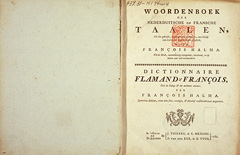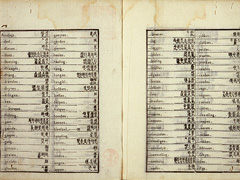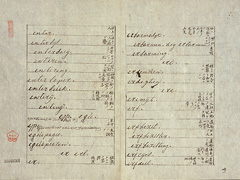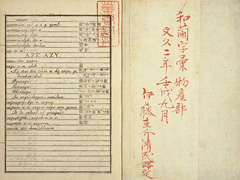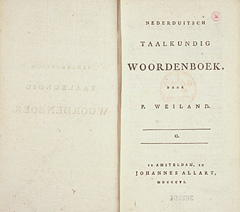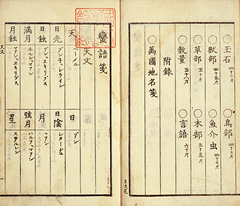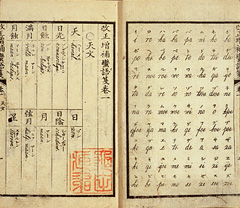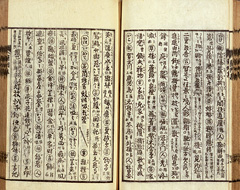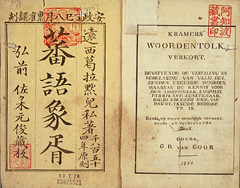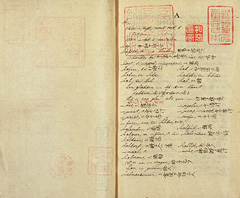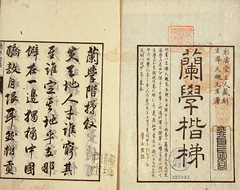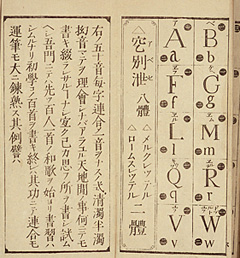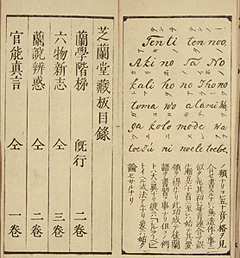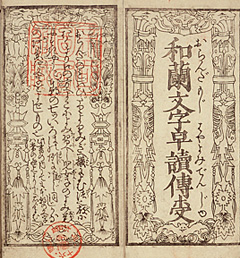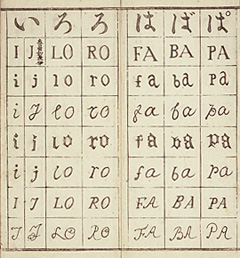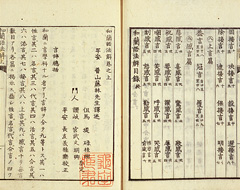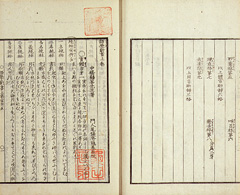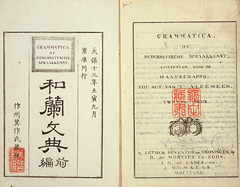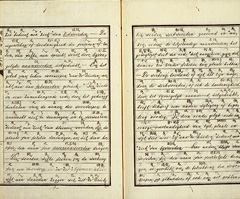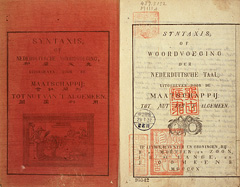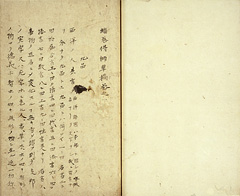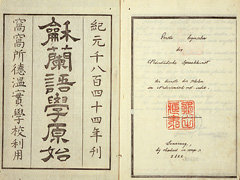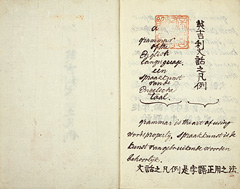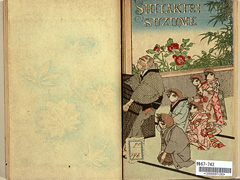This is F. Halma's Dutch-French dictionary. The first edition was published in 1710. The first good Dutch-Japanese dictionaries Haruma wage (Edo Haruma) and Dufu Haruma (Nagasaki Haruma) were created based on this dictionary. Our copy is the fourth edition printed in The Hague in 1781, but many other editions were also imported into Japan.
Home | Part 2: View by Topics | 3. Studying the Dutch Language
Part 2: View by Topics
3. Studying the Dutch Language
The study of the Dutch language in Japan was started by interpreters assigned to negotiate with the Dutch on Deshima. Young people were chosen as future Dutch interpreter candidates, and were instructed in the Dutch language directly by Dutchmen. The work of Dutch interpreters was hereditary, and knowledge of the Dutch language was passed down from parents to children in these families.
The study of not only language but also of other Western subjects expanded in the latter half of the 17th century, as trade between Japan and the Netherlands expanded. Dutch interpreter families known to have engaged in this scholarly research include the Yoshio family, Shizuki family, and Motoki family.
In Edo during the late 18th century, Maeno Ryotaku and Sugita Genpaku et al. produced the translated work Kaitai shinsho, while Dutch language instruction was given at Shirando, the private school of Otsuki Gentaku, and in 1796, Inamura Sanpaku, a pupil of Gentaku's, published Haruma wage, the first Dutch-Japanese dictionary in Japan.
In the 19th century changes in world affairs also impacted Japan and the study of English was begun among the Dutch interpreters in Nagasaki. Also in the 1810s, when the arrival of Dutch ships was almost completely cut off, the chief of the Dutch factory H. Doeff began his own Japanese translation of F. Halma's Dutch-French dictionary, and after H. Doeff returned home, this was completed as Dufu Haruma by the Nagasaki Dutch interpreters in 1833. There were also private schools established outside of Nagasaki and Edo to teach Dutch, and one of the better-known of these was Tekijuku established in Osaka by Ogata Koan. In 1858, Fukuzawa Yukichi established the private Dutch studies school in Edo, which was the predecessor of Keio University.
[Dictionaries]
Halma Dictionary
Halma, F.: Woordenboek der nederduitsche en francsche taalen.
4. druk. Hage: J. Thiery & C. Mensing, 1781. 1 v. <蘭-993>
Yakken.
Edited by Fujibayashi Fuzan. S.l.: s.n., 1810? 3 v. <216-131>
This is an abbreviated edition of the Haruma wage (Edo Haruma), and is edited and published by Fujibayashi Fuzan (Taisuke, 1781-1836) who was a pupil of Inamura Sanpaku (1758-1811). The formal name of this dictionary is Nederduitche TAAL. Yakken. It consists of three volumes, the Ken and Kon volumes and an appendix, and contains approximately 30,000 entries. This is the second-oldest Dutch-Japanese dictionary published in Japan.
[Haruma jisho]
Transcribed by Takano Choei. 1 sheet. <YR8-N80>
This is a transcription of Inamura Sanpaku's Haruma wage (Edo Haruma) and is said to have been transcribed by Takano Choei. Belonged to the Nunokawa Collection.
Oranda jii.
Tr. by Do-shi. Rev. by Katsuragawa Hoshu et al. Edo: Yamashiroya Sahei, 1855-58. 12 v. <蘭-96 to 107>
The 7th Katsuragawa family head Katsuragawa Hoshu (Kunioki, 1826-1881) published this Dutch-Japanese dictionary with the permission of the Shogunate government. It has approximately 50,000 entries. This dictionary is a revised and enlarged edition of the Dufu Haruma, which was commonly called Nagasaki Haruma, and was the most complete Dutch-Japanese dictionary printed and published in Japan during the Edo period. Belonged to the Bureau for the Inspection of Barbarian Books.
Other Dictionaries and Glossaries
Weiland, P.: Nederduitsch taalkundig woordenboek.
Amsterdam: J. Allart, 1799-1811. 11 v. <蘭-1010 to 1020>
This is a Dutch dictionary (Dutch-Dutch) compiled by P. Weiland. According to Fukuzawa Yukichi (1835-1901) in his Fuku-o jiden, this dictionary was kept together with the Haruma dictionary at the Tekijuku in Osaka.
Bango sen.
By Morishima Churyo. S.l.: s.n., 1798? 1 v. <わ813-19>
This book is a changed title of Ruiju komo goyaku (1798) compiled by Morishima Churyo (1754-1808) and published under the pen name Kuma Shuei. It is a Japanese-Dutch glossary containing approximately 1,800 words, and is divided into sections such as 'astronomy', 'geography', 'annual events' and 'humanities'. This style might be influenced by such dictionaries as the Shinbunkan made by the Qing Dynasty. In this book, the Dutch glossary that corresponds to a Japanese glossary is written in katakana rather than the alphabet, and the end of the book includes a Bankoku chimeisen showing the world place names in Dutch. Belonged to Japanese language scholar Okada Mareo.
Kaisei zoho Bango sen.
By Morishima Churyo. Enl. by Mitsukuri Genpo. Koto: Suharaya Ihachi, etc., 1857. 2 v. <849.3-M556k>
This is a revision and enlargement of the previous Bango sen done by Mitsukuri Genpo, and the first edition was published in 1848. This book shows the Dutch glossary in katakana and the alphabet and also added the sections 'Firearms', 'Phrases' and 'Conversation'. Belonged to the Kameda Collection (Japanese).
Ranrei setsuyoshu.
Edited by Hirokawa Kai. Kyoto: Hirokawa Yochisai, 1815? 1 v. <本別14-7>
This is a Japanese dictionary in order of the Japanese syllabary. It is edited by Hirokawa Kai (dates of birth and death unknown), a Kyoto physician who studied in Nagasaki. The book was named Ranrei (Dutch style) because the entries were ordered in the Japanese syllabary taking a hint from the Dutch dictionaries that were ordered in alphabetical order. A glossary of Dutch words, such as kateiteru (catheter), was incorporated, and illustrations were added for items like plants and instruments. It was privately printed in Kyoto.
Bango shosho.
By Kuramerusu. Hirosaki: Sasaki Genshun, 1857. 2 v. <W142-67>
Jisho genko.
Transcribed by Nishimura Shigeki. Ms. 2 v. <827-176>
This is a Dutch-Japanese dictionary transcribed by Nishimura Shigeki (1828-1902). The number of Dutch dictionaries in circulation during the Edo period was few and they were expensive, so Dutch studies scholars often transcribed them.
[Primers and Grammar Books]
Rangaku kaitei.
By Otsuki Gentaku. Toto: Matsumoto Zenbei, etc., 1788. 2 v. <402.1059-O932r-II>
This is a Dutch studies primer compiled by Otsuki Gentaku (1757-1827). It includes an explanation of Dutch letters and numbers. "The woodblock is carved and possessed by the head of Saiundo" is printed on the endpaper, and this is the first edition published with the assistance of Lord Kutsuki Masatsuna of the Fukuchiyama Domain. This was the first primer on Dutch studies in general published in Japan, and many editions of it were printed. It made an important contribution to the spread and development of Dutch studies in Japan. Belonged to the Kameda Collection (Japanese).
Rangaku haikei.
Edited by Yoshikawa Yoshisuke. Edo: Shiran Kajuku, 1811. 1 v. (accordion fold) <172-44>
This is a folding Dutch alphabet table. This was originally created by Yoshikawa Yoshisuke, a pupil of Otsuki Gentaku, in 1796 for the first students of Shirando, and was reprinted by Otsuki Genkan with an added supplement.
Oranda moji hayayomi denju.
By Tamiya Chusen. Naniwa: Akitaya Taemon, 1814. 1 v. (accordion fold) <す-69>
This is a folding Dutch language primer. The author is Tamiya Chusen (Kitsuan, 1753?-1815) who was not a Dutch studies scholar, but was known as a humor novel and essay author. He was active in Kansai and wrote books on a variety of subjects.
Oranda goho kai.
Tr. by Fujibayashi Fuzan. Osaka: Kawachiya Kihei, etc., 1815. 3 v. <849.3-H884o>
This is a Dutch grammar book written by Fujibayashi Fuzan. It was the first Dutch grammar book published in Japan. It contains a forward by Baba Sajuro (1787-1828). who was a former Nagasaki interpreter, made many translations at Tenmonkata, and became a vassal of the Shogun in 1814. Belonged to the Kameda Collection (Japanese).
Gogaku shinsho.
By Tsurumine Shigenobu. Rev. by Saito Harumasa. S.l.: s.n., 1833? 1 v. <815-Tu766g2-S>
This is a Japanese grammar book written by Japanese literature scholar Tsurumine Shigenobu (1788-1859). One of its features is that the parts of speech are classified similar to that of Dutch grammar. Belonged to the Kameda Collection (Japanese).
Oranda bunten. Zenpen.
By Maatschappij tot Nut van 't Algemeen. Koto: Suharaya Ihachi, etc., 1857. 1 v. <439.315-M111g>
This is a reprint of the Dutch grammar book Grammatica of Neederduitsche spraakkuunst (1822) that was written and published by Maatschappij tot Nut van 't Algemeen, a textbook publishing company established in 1784. Japanese reprint publisher Mitsukuri Genpo (1799-1863) carved the woodblock using the cursive letters, and published the first edition in 1842. This is the reissue of it. According to Fukuzawa Yukichi in his Fuku-o jiden and Nagayo Sensai in his Shoko shishi, it is stated that at the Tekijuku in Osaka this Grammatica was used as a Dutch language primer to teach beginners and was completed in six months.
Kunten Oranda bunten.
S.l.: Sosetsukan, 1857. 1 v. <239-121>
Oranda bunten. Kohen.
By Maatschappij tot Nut van 't Algemeen. Sakushu: Mitsukuri-shi, 1848. 1 v. <439.3152-M111s>
This is a reprnt of the Dutch syntax textbook Syntaxis of woordvoeging der Nederdutische taal (1810) that was written by Maatschappij tot Nut van't Algemeen, the same company that published Grammatica. As with Grammatica, Genpo carved the woodblock using the cursive letters.This book is a textbook on Dutch syntax for students who have finished the beginner grammar book Grammatica, and as with Grammatica, at the Tekijuku it was completed after six months of study.
Hankan Tokushi soko. (Incl. in Kaigai jirui zassan, v. 4)
By Takano Choei. Ms. 1 v. <寄別14-25>
This is a draft of an introduction of Dutch for beginners written by Takano Choei (1804-1850). It is possible that our copy is the autograph of Choei. It was written based on Choei's knowledge of Dutch gained from Dutch interpreter Yoshio Gonnosuke (1785-1831) while he was studying in Nagasaki. It is thought to have been completed around 1828-29.
Oranda gogaku genshi.
S.l.: s.n., 1856. 1 v. <439.315-E26>
This is a reprint of the Dutch language textbook Eerste beginselen der Nederduitsche spraakkunst (Samarang, 1844) by the feudal school Meidokan of the Echizen Fukui Domain. This textbook had been used in schools in the Dutch East Indies. This reprint exemplifies the boom in Dutch studies throughout Japan that was prompted by the arrival of M. C. Perry.
[English Languages References]
Igirisu bunwa no hanrei.
By Yoshio Gonnosuke. Autograph. 2 v. <特7-47>
This is an English conversation phrase book written by Nagasaki interpreter Yoshio Gonnosuke. The Phaeton Incident of 1808 was the direct cause of the Shogunate government commanding the Nagasaki interpreters to also study English. After this incident, the Shogunate government felt the need to reinforce the defenses at Nagasaki against further arrivals by English ships and to be prepared to interpret English, and so had the Nagasaki interpreters study English. This book was prepared as a textbook for learning English. Belonged to the Ito Collection (Japanese).
Column: Shitakiri suzume.
Shitakiri suzume.
Tr. by Fan Sukerunbeki. Illustrated by Sensai Eitaku. Tokyo: Kobunsha, 1886. 1 v. <特67-743>
This is the Dutch language version of the Shitakiri suzume, one of the so-called chirimen bon (crepe-paper books) that were created for foreigners during the Meiji period. Our copy is a hiragami-bon (prints on plain paper). This was translated by Pieter Gerard van Schermbeek and the Dutch title is De musch met de geknipte tong. This book is the last Dutch language book published in Japan in the 19th century owned by the National Diet Library.
Copyright © 2009 National Diet Library. Japan. All Rights Reserved

